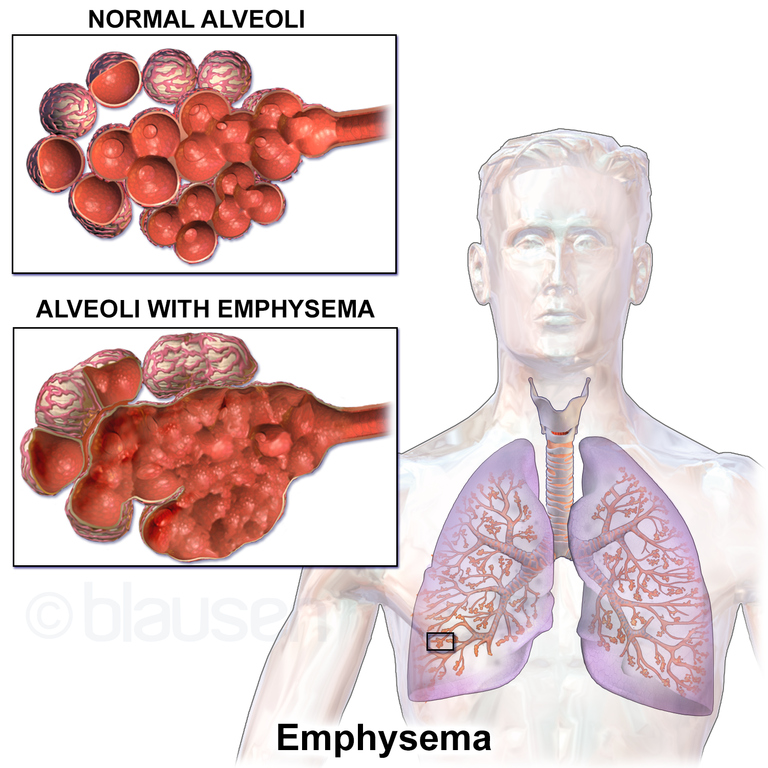
There are many different types of lung and respiratory conditions that can cause problems as you get older, especially if you smoke. One of the most common respiratory diseases is Chronic Obstructive Pulmonary Disease (COPD), which is an umbrella condition that includes two serious diseases: chronic bronchitis and emphysema.
Many people, even doctors, sometimes confuse the signs of emphysema and chronic bronchitis. These two diseases share many early symptoms and share the fact that they are chronic, incurable respiratory conditions. In other ways, however, they are very different.
Understanding these differences is essential for diagnosing lung diseases, and preventing unnecessary lung damage and complications. This article will show you how to differentiate the signs and symptoms of emphysema and chronic bronchitis and help you understand the different treatments and medications that are effective for fighting these diseases.
What is Chronic Bronchitis?

Acute bronchitis is a common, short-term condition that otherwise healthy people can get, and it's usually the result of a respiratory infection. However, smoking and exposure to other respiratory toxins can cause chronic bronchitis, a much more serious condition in which bronchitis symptoms keep coming back and last for months or years at a time.
Acute bronchitis only lasts a few days or weeks, but chronic bronchitis lasts a lifetime. Symptoms include breathlessness and a chronic, phlegmy cough that either refuse to go away or keep coming back over the course of many years.
Chronic bronchitis occurs because of irritation in the bronchial tubes, which are the airways that carry air to and from your lungs when you breathe. When they are irritated frequently over a long period of time (whether from smoke, infections, or other causes), it causes irreversible damage to tissues in your airways.
The walls of the bronchial tubes get thicker and stiffer and secrete extra amounts of mucous that clog them up and block air from passing through. This makes your airways narrower, makes it difficult to breathe, and causes frequent coughing that often brings up mucus.

These changes to the airways are permanent and tend to get worse over time. But with early detection and treatment, you can slow down the damage that chronic bronchitis does to your airways and prevent more serious complications.
What is Emphysema?
While chronic bronchitis is a result of damage and obstruction in the bronchial tubes, emphysema occurs as a result of damage in the lungs. It happens when irritation and inflammation (from smoke or other irritants) destroys tissue in the tiny air sacs—known as alveoli—in the lungs.
Healthy alveoli are very efficient at taking up oxygen because the tiny, round air sacs have a lot of surface area to absorb the gas. But if you have emphysema, the walls in-between the air sacs get broken down, turning many tiny air sacs into fewer, bigger ones. This severely impairs your lungs' ability to absorb oxygen from the air you breathe.
Emphysema also causes other changes to the structure of the lungs, damaging the soft, elastic tissue that allows them to expand and contract with ease. Lung tissue that has been damaged by emphysema (known as emphysemous tissue) gets thicker, stiffer, and inelastic, preventing the lungs from collapsing all the way and pushing all the air out when you breathe.
The stiffened alveoli are no longer able to expand and deflate normally, and get permanently stretched out. As a result, the lungs can't absorb oxygen efficiently and pockets of air are left in your lungs every time you exhale.
When air gets trapped in the lungs like this, it means that they can't take in as much fresh, oxygen-rich air the next time you breathe. This can cause breathlessness and make it difficult to inhale, straining the heart and eventually leading to hypoxia (low blood oxygen levels) as more and more lung tissue becomes damaged.
Why Understanding the Difference between Emphysema and Chronic Bronchitis is Important

Both chronic bronchitis and emphysema are serious, life-threatening diseases with no known cure. They are progressive diseases, meaning they tend to cause more and more permanent damage to your lungs and get worse with time.
Fortunately, modern treatments for emphysema can slow the progression of both diseases, reduce symptoms, and improve patients' overall quality of life. That's one reason why understanding the differences between emphysema and chronic bronchitis is important; knowing exactly what kind of lung condition you have is necessary to make sure you get the right kind of treatment.
Proper, early treatment for COPD can be life-saving and help prevent the disease from causing further scarring and damage to the lungs. That's why you should never ignore the symptoms of chronic bronchitis or emphysema, such as a chronic cough or frequent breathlessness.
If you experience these symptoms often, especially if you smoke, you should see your doctor immediately to get checked for COPD.
One reason chronic bronchitis and emphysema are often mixed up is that many people are diagnosed with both diseases at the same time. That's because respiratory irritants and lung inflammation is a common root cause of both diseases.
As a result, many people exposed to smoke and other toxic chemicals throughout their lives develop emphysema and chronic bronchitis simultaneously. More than 11 million adults in the US have been diagnosed with COPD, and researchers believe there are many more living with the disease who are unaware.
But despite having similar causes and symptoms, the biological effects of both diseases are very different. When they use the right equipment, doctors are usually able to see the difference between emphysema and chronic bronchitis with ease, even when a patient is suffering from both conditions.
Emphysema and Chronic Bronchitis Share Many Common Causes
Chronic bronchitis and emphysema are both the result of long-term respiratory irritation or infections. The most common trigger for both diseases is long-term exposure to respiratory irritants like smoke, dust, and toxic fumes.
People who smoke cigarettes or don't properly protect their lungs from workplace hazards are at a higher risk for both emphysema and chronic bronchitis. Some people develop one or the other, but a great many people end up developing both conditions at the same time.
To better understand how each disease works, let's take a closer look at some of the common causes and symptoms of both emphysema and chronic bronchitis.
What Causes Emphysema?

Smoking is the number one cause of emphysema, but long-term exposure to other irritants like dust, pollen, and chemical fumes can also cause the disease. However, how these respiratory toxins lead to emphysema is very different than how they cause chronic bronchitis.
These things hurt your lungs because they cause damage to microscopic hair-like structures called cilia that line the inside of the lungs. These tiny hairs move back and forth and act like brushes that move irritants, like dust and smoke particles, out of the lungs.
Cilia are the only tool your lungs have to clean out harmful foreign particles and mucus build-up in the lungs. But when they're repeatedly exposed to smoke or other irritants, the cilia get damaged and paralyzed, and let mucus, bacteria, dust, allergens, and other particles build up inside the lungs.
This leads to the chronic irritation and inflammation that results in permanent damage to the lung tissue and air sacs. The alveoli get broken down and stiffened, reducing the lungs' ability to absorb oxygen, and the damaged tissue impairs the lungs' ability to expand and contract, making it difficult to breathe.
Here is a list of common irritants that can cause emphysema with long-term exposure:
- Smoking (or exposure to second-hand smoke from cigarettes, fires, wood-burning stoves, etc.)
- Air pollution
- Dust (especially from workplace exposure)
- Asbestos
- Chemical fumes (especially from workplace exposure)
There is another unique cause of emphysema, a rare genetic disease known as Alpha-1 Antitrypsin deficiency (or simply Alpha-1). People with this disease lack an important functional protein that helps protect their lung tissue from irritation and inflammation, and can lead to permanent lung damage and emphysema.
Other diseases that cause inflammation in the lungs, like cystic fibrosis, can also cause emphysema over time.
What Causes Chronic Bronchitis?

All of the same irritants that can irritate your lungs can also cause inflammation in the bronchial tubes. Inhaling smoke particles, dust, or other toxins causes irritation and swelling in the airways that makes it difficult to breathe.
This causes mucus and bacteria buildup that can lead to worse inflammation, infection, and a variety of respiratory symptoms. It can also damage the tiny cilia that line the bronchial tubes, making it difficult to clear the mucus and other particles out of your airways.
Chronic bronchitis can also be caused by repeated respiratory infections and severe asthma. Although it only happens in rare cases, repeated long-term inflammation from infection can lead to permanent damage to the airways and cause you to develop chronic bronchitis.
Here is a list of common irritants that can cause chronic bronchitis with long-term exposure:
- Smoking (or exposure to second-hand smoke from cigarettes, fires, wood-burning stoves, etc.)
- Air pollution
- Dust (especially from workplace exposure)
- Asbestos
- Chemical fumes (especially from workplace exposure)
- Repeated respiratory infections or severe asthma (especially during childhood)
Symptoms of Emphysema and Chronic Bronchitis Can Be Similar
Symptoms of COPD can develop quickly, but it usually takes a long time, even years, for major symptoms to appear. Many of the early symptoms of chronic bronchitis and emphysema can be identical, but there are some notable, distinct differences if you know what to look for.
Symptoms of Emphysema

Emphysema takes many years to develop, and most people don't experience symptoms until they are 40-60 years old. The most common symptoms are breathlessness with exercise and fatigue that get worse over time.
There's a trick often used in the medical community to help people distinguish between the two diseases and remember the different symptoms. They use the colorful terms “pink puffers” and “blue bloaters” to highlight the main differences in symptoms between late-stage emphysema and chronic bronchitis.
“Pink puffer” refers specifically to people with severe emphysema who experience severe shortness of breath (puffing) and have a thin, skeletal physique. That's because, in the late stages of the disease, emphysema makes your heart and lungs work harder, makes it difficult to breath, and uses up a lot of extra energy.
This can lead to severe weight loss and muscle wasting that leads to the skinny appearance associated with the “pink puffer.” Fortunately, because of earlier diagnosis and modern medical treatment, such severe changes in physical appearance are rarely seen in people with emphysema today.
The most common early symptoms of emphysema include shortness of breath, wheezing, and a cough that won't go away. As the disease progresses and lung damage worsens, many people with emphysema feel breathless even at night or while at rest and require supplemental oxygen therapy.
Common symptoms of emphysema:
- Shortness of breath
- Wheezing
- A cough that won't go away
- Chest tightness and discomfort
- Rapid breathing
- Fatigue
- Weight loss
- Reduced appetite
Late stage symptoms of emphysema:
- Hypoxia (low oxygen levels in the blood)
- Blue tint to skin and lips
- Weight loss
- Swelling in the legs and ankles (edema)
Symptoms of Chronic Bronchitis
Most people begin developing the first symptoms of chronic bronchitis when they're in their forties or fifties. However, people who smoke heavily or have a history of severe asthma sometimes develop chronic bronchitis much earlier.
The term “blue bloater” is used to describe people with late-stage chronic bronchitis who tend to have a swollen, barrel-chested physique. That's because chronic bronchitis is very straining for the heart and can lead to swelling in the limbs (edema) and right-side heart failure. This results in the classic “blue bloater” appearance, although it is much less common to see in recent years as a result of modern medical treatments and earlier diagnosis.
The most common early symptom of chronic bronchitis is a severe, phlegmy cough that persists for weeks and months. Episodes of worsened symptoms can also come with a fever, chills, and fatigue.
Unlike emphysema, symptoms of chronic bronchitis tend to come and go, especially in the early stages of the disease. It's common for symptoms to lessen or disappear for short periods of time and then return in full force without warning.
When you have chronic bronchitis, you have to watch out for a number of things that can trigger your symptoms and make your disease worse. Getting sick with the cold or flu, getting an infection, or getting exposed to dust, pollen, or air pollution can all cause episodes of increased symptoms.
Common symptoms of chronic bronchitis:
- Persistent, severe cough that brings up mucus
- Thickened, discolored mucus
- Shortness of breath
- Wheezing
- Chest pain and discomfort
- Sinus congestion
- Fatigue
- Fever
- Chills
- Bad breath
Late stage symptoms of chronic bronchitis:
- Hypoxia (low oxygen levels in the blood)
- Blue tint to skin and lips
- Swelling in the legs and ankles (edema)
Diagnosing Emphysema and Chronic Bronchitis

While, on the surface, chronic bronchitis and emphysema might seem similar, their differences show up on chest x-rays and other diagnostic tests. If you know what to look for, serious cases of both chronic bronchitis and emphysema can be spotted simply by looking at the shape and structure of the lungs and airways.
Chronic bronchitis can be seen by looking at the bronchial tubes. It often shows up through thickened airway walls, enlarged blood vessels, and scarring in the airways.
Emphysema is often diagnosed by looking at the lungs, especially the upper lobes, through chest x-rays and CT scans. Seriously damaged tissue shows up on scans as dark regions of emphysemous tissue and are referred to as bullae.
If you see a doctor for symptoms of COPD, your doctor will likely take a variety of chest x-rays, CT scans, and lung function tests. To see if you have emphysema or chronic bronchitis, he will look at your lungs, bronchial tubes, and the results of other tests together to give you an accurate diagnosis.
Effective Treatment Options for Chronic Bronchitis and Emphysema
Most of the treatments for both chronic bronchitis and emphysema focus on protecting the lungs from further damage and making it easier to breathe.
Most of the same medications, treatments, and airway clearance techniques used to treat emphysema can also be used to treat chronic bronchitis. The most important first step toward treating both diseases is to quit smoking and avoid exposure to secondhand smoke and other irritants.

Common treatments for emphysema and chronic bronchitis:
- Quit Smoking: Smoking is, by far, the most common cause of both chronic bronchitis and emphysema. If you still smoke, quitting is the best thing you can do to keep your lungs healthy and prevent continued, permanent damage to your lungs. If you need help quitting, you can talk to your doctor to learn about smoking cessation programs and medications, or visit the American Lung Association's website for more information that can help. http://www.lung.org/stop-smoking/
- Pulmonary Rehabilitation: Pulmonary rehabilitation is a special class for people who suffer from respiratory diseases like emphysema and chronic bronchitis. It usually consists of a combination of exercise classes, support groups, and lessons on how to manage your symptoms. At pulmonary rehab you will learn how to keep your lungs healthy, use your medication, and manage breathlessness during physical activity. It's a great way to learn how to be more active and live a more fulfilling life with COPD.
- Supplemental Oxygen: Both chronic bronchitis and emphysema cause irreversible damage to the lungs and airways that makes it difficult for your lungs to get enough oxygen. As the disease progresses, it gets more and more difficult to breathe and you might need to use a supplemental oxygen device to reduce shortness of breath and make sure you have enough oxygen in your bloodstream. There are a variety of tanks and oxygen concentrators to choose from that fit different lifestyles and oxygen needs, and you doctor can help you decide what's right for you.
Common medications for treating emphysema and chronic bronchitis:
- Bronchodilators: Bronchodilators help relax and dilate (open up) your airways and are often prescribed both to people with emphysema and chronic bronchitis. This makes it easier to breathe and temporarily reduces symptoms like breathlessness and wheezing.
- Corticosteroids: Corticosteroids work as a powerful anti-inflammatory medication and can be effective for treating irritation in both the lungs and bronchial tubes. They can be inhaled, injected into the bloodstream, or taken as an oral medication as a temporary treatment for worsened symptoms and inflammation. Because they can cause serious side effects, however, they should only be taken for short periods of time under close supervision from your doctor.
- Antibiotics: Irritation in the lungs (from emphysema) and airways (from chronic bronchitis) traps bacteria and makes you more prone to respiratory infections. People with emphysema or chronic bronchitis often have to take antibiotics to fight off infections that worsen symptoms and could cause further damage to tissues in their lungs and airways.
- Alpha-1 Antitrypsin Protein Therapy: This is a treatment that only works for patients who develop emphysema as a result of having the genetic disease Alpha-1 antitrypsin deficiency. The therapy involves getting weekly injections of a protein that helps protect the lungs from inflammation. If therapy is begun early enough, it can prevent people with Alpha-1 from developing future lung damage and emphysema.

Surgeries sometimes used to treat emphysema (but not chronic bronchitis):
- Lung Volume Reduction Surgery: Lung volume reduction surgery is an option for some patients with severe emphysema, but would not help patients with chronic bronchitis. This surgery involves removing damaged, emphysemous tissue from the lungs and leaving the healthier, stretchier tissue behind. This helps reduce air pockets in the lungs that trap air and make it difficult to breathe, and can significantly reduce patients' symptoms in many cases.
- Lung Transplant Surgery: Some patients with advanced emphysema may be eligible for a lung transplant surgery. Although it is a very risky procedure, it is used as a last resort for qualified patients with life-threatening lung disease. However, not everyone qualifies for an organ transplant, and waiting lists for viable organs can be long.
Conclusion
Despite their similarities, chronic bronchitis and emphysema are distinct diseases that cause recognizable changes to the lungs and airways. Although they are both part of COPD and often go hand-in-hand, some people only get chronic bronchitis or emphysema alone.
Both are long-term, life-threatening diseases that can be treated and slowed down with proper medical treatment and lifestyle changes if caught early enough. If you notice that you have any symptoms of COPD, you should see your doctor right away for a diagnosis.
Chronic bronchitis and emphysema can be difficult to tell apart at first glance but they cause more distinct symptoms and complications as they progress. Fortunately, with proper training and the right medical diagnostic tests, knowledgeable doctors can reliably differentiate between the two diseases and ensure their patients get the treatments they need.


.png)





